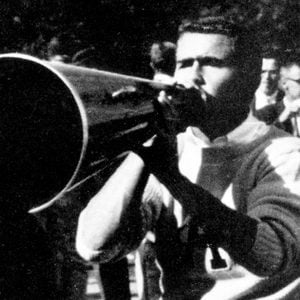Over the past 39 years, Jimmy Carter's housing initiative has given families in need a place to call home and shone a spotlight on the issue of affordable housing
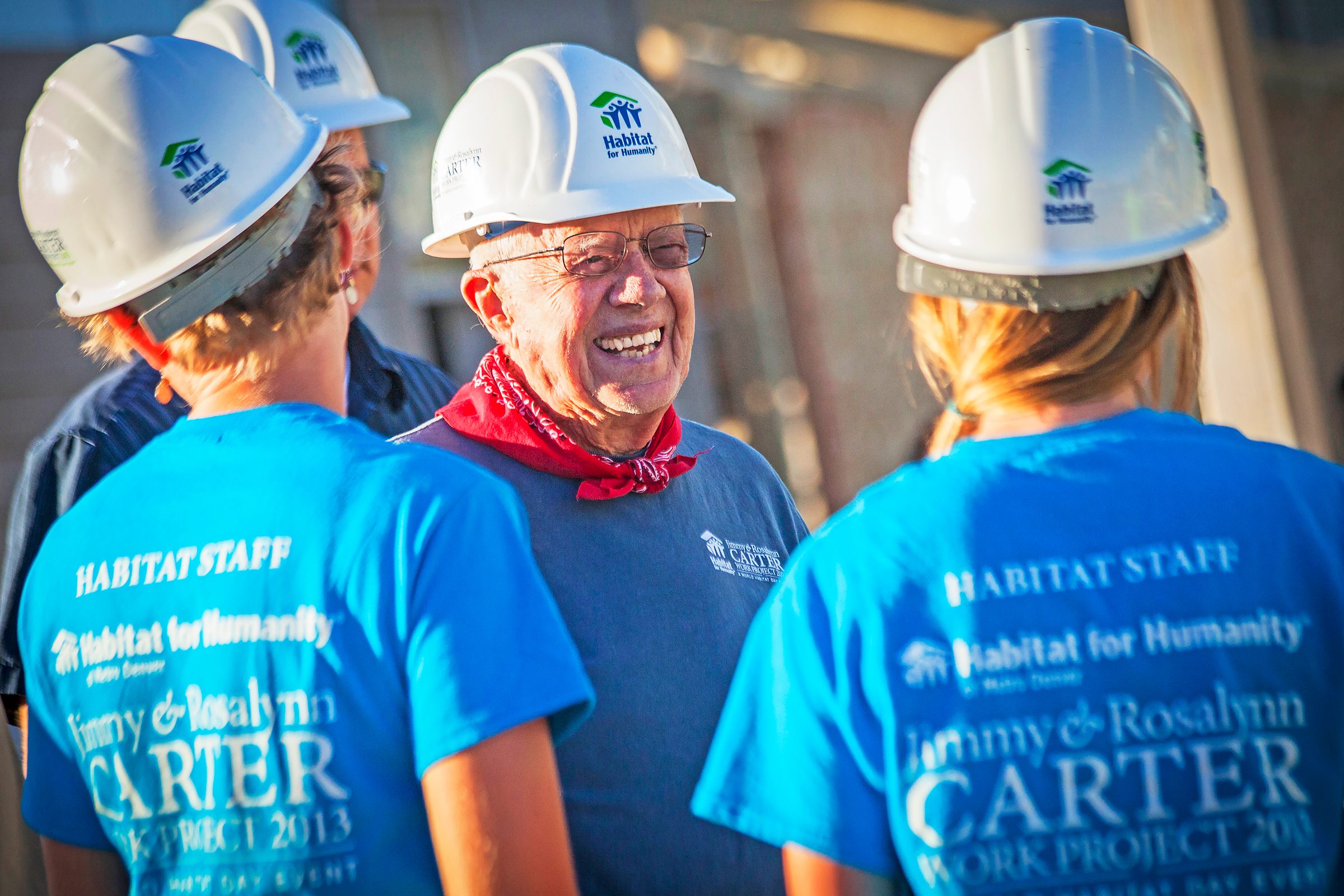
Former President Jimmy Carter Built My House—and Changed My Life

By the time Erica Roman Rittle’s daughter was 3 years old, she had already called five places home. When Erica and her husband, Neil Rittle, learned that their application to Habitat for Humanity of Greater Nashville had been accepted as part of the 2019 Jimmy Carter housing initiative known as the Carter Work Project, they and their three children were living in an overcrowded apartment with sealed-shut windows and poor ventilation. On at least one occasion, a neighbor chased someone through the hallways with a shotgun. Erica admitted that she didn’t feel safe in that environment, but the lack of affordable housing necessitated that she and her family live wherever they could, regardless of how dangerous it felt.
In Mishawaka, Indiana, just outside of the University of Notre Dame, Ambera Pruitt was at work when she received a phone call from an unknown number and sensed her life was about to change. On the other end of the line was Andrew Cary of Habitat for Humanity of St. Joseph’s County, with news that she had been accepted into the 2018 Carter Work Project. After receiving the call, Pruitt rushed into the hallway, where her boss was waiting to celebrate with her. October will mark five years since Pruitt and her two daughters closed on their home. The occasion called for an impromptu pizza party on the floor of what is now officially their dining room.
Perhaps a young Jimmy Carter anticipated the impact he’d have on those in need. Or perhaps he looks back in astonishment at the strides he made not as a president but as a volunteer: Since the inaugural Jimmy Carter Habitat for Humanity project in New York in 1984, President Jimmy Carter and his wife, Rosalynn, have helped renovate, build and repair 4,390 homes in 14 countries, alongside 104,000 volunteers. The Pruitts and Roman Rittles are just a fraction of the countless individuals impacted by the former president and first lady across the United States—and the world.
Get Reader’s Digest’s Read Up newsletter for more inspiring true stories, humor, cleaning, travel, tech and fun facts all week long.
A matter of affordable housing
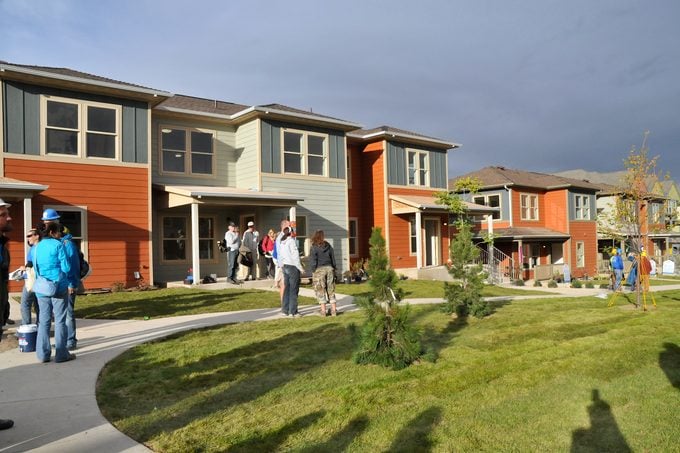
Mario and Phyllis Mora had lived in their home in the Metro Denver neighborhood of Globeville for 35 years when they linked up with Habitat for Humanity through their church. After learning they’d been accepted into the 2013 Carter Work Project, Mario spent five months hand-carving an aluminum teardrop peace sign and wooden display box as a thank-you present to the former president and first lady.
When Carter arrived that fall, he would bring help to families like the Moras. And he’d bring home the importance of affordable housing nationwide. “[Carter] was a megaphone for bringing in other leaders to better understand the situation and to focus in on the housing crisis so many communities face,” says Heather Lafferty, CEO of Habitat for Humanity of Metro Denver.
Over the course of a single week in October 2013—and for months leading up to the project and following it—the Carter Work Project shone “the world’s spotlight” on the underserved community of Globeville and its residents. About 2,000 volunteers joined the former president and first lady for five intensive days of work building 11 new homes and repairing 15 homes in a neighborhood bisected by interstate highways and surrounded by industrial areas.
The impact on the community was significant. The impact on each new homeowner was even greater. “He and his wife have very big hearts for doing this,” says Phyllis. “It was a big blessing for us.”
Leading by example
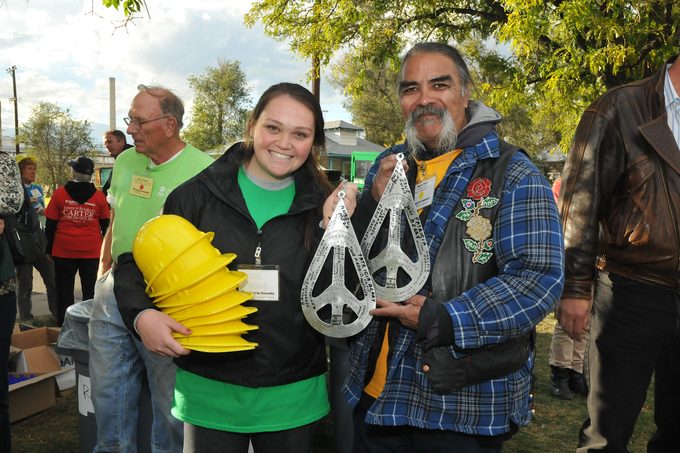
Thanks to the team of volunteers who descended on their home, the Moras received a new handicapped ramp and driveway, along with repairs to the garage and exterior of the house. That ramp and driveway are in frequent use by visitors to the home, and Mario spends hours each day in his garage. It was there that he created the peace sign hand-stamped with the Carters’s names, as well as the names of all the recipient families of that year’s Carter Work Project build.
He remembers Carter as a man who was deeply involved with peace work during his presidency, but it was an entirely different experience to see the former president in the Globeville neighborhood. “He didn’t come to just make a speech,” Mario says. “He was working, and so was his wife, whatever they needed to do.”
Mario recounts a piece of presidential trivia, a story similar to those told by other Habitat for Humanity families and employees. The former president didn’t tolerate idleness, so if he saw a group of volunteers standing around, he would say, “Here, take my hammer—I have another one.” In other words: Get back to work.
The Carters modeled a lead-by-example approach and were active builders on construction sites. Reporters were allowed only in a designated media area, and photo ops were reserved for the final day of the build. The former president didn’t want anything interfering with the job at hand. These builds had been his passion for decades, since the fateful day in 1984 when the idea for the Jimmy Carter housing project took hold. Speaking of photos, check out these iconic pictures of a young Jimmy Carter that tell his life story.
The Jimmy Carter housing project
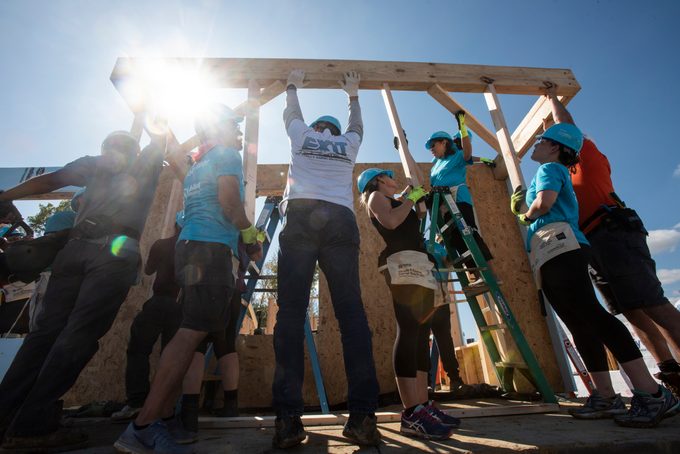
Former President Jimmy Carter was jogging through New York City one day in 1984—three years after he left the White House—when he passed by a Habitat for Humanity build. In that moment, he had a life-altering realization: In his post-presidency years, he and Rosalynn could bring attention to the need for affordable housing.
Despite the slew of perks that former presidents enjoy, Carter lived a humble life after leaving the presidency. The couple had lived in the same modest ranch home in Plains, Georgia, since 1961 (and still live in that house to this day). The man who called the same address home through his career as a state senator, governor, United States president and former president certainly understood the stability and security inherent in having a home of one’s own.
True to his word, the former president led a group of volunteers to New York City to renovate the 19-unit Mascot Flats apartments. Through that simple act, the Jimmy Carter housing project, known officially as the Carter Work Project, was born.
For the next 35 years, the Carters would be a familiar and well-known feature on the annual build.
Building a sense of security
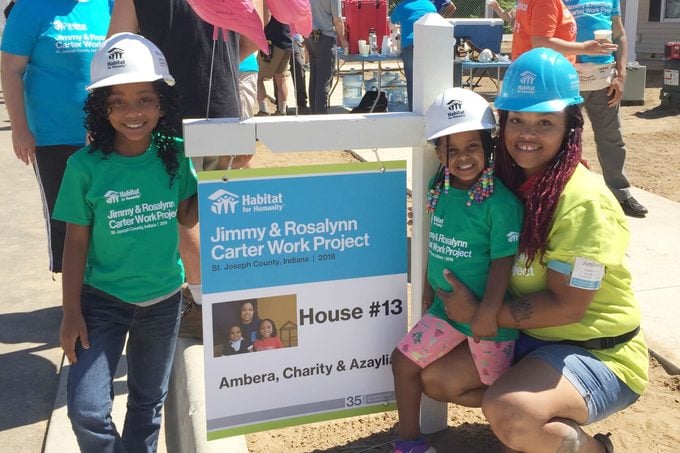
For the 14,000 families in St. Joseph’s County, Indiana, who pay 50% or more of their income for housing, the dream of homeownership can seem impossible. Yet the benefits of owning a home go beyond the financial.
Ambera Pruitt understands this well. Growing up, her family rented, which meant they moved often. So when she considered her living situation, she prioritized the stability and routine that homeownership offers. She believes they’re essential to allowing people to thrive.
For years, though, the goal of owning a home was out of reach. That is, until the Carter Work Project came to town. Through an extensive process of applications, classes and volunteer work on-site—a 250-hour commitment commonly known as “sweat equity”—homeownership is becoming a reality for people like Pruitt.
In 2018, in this small community on the outskirts of the University of Notre Dame, she and 21 other families became homeowners. Carter (already well into his 90s), Rosalynn, country music stars Trisha Yearwood and Garth Brooks, and TV personality David Letterman led more than 1,000 volunteers through the build that gave those lucky residents a place to call their own.
Today, Pruitt, her daughters and their adopted dogs live in the Fields of Highland neighborhood, where her children have friends and where neighbors watch out for one another’s kids. Many went through the Habitat for Humanity experience together, so they know and trust one another. “The neighborhood is my family,” she says, “and Habitat facilitated that.”
An inspiration for all
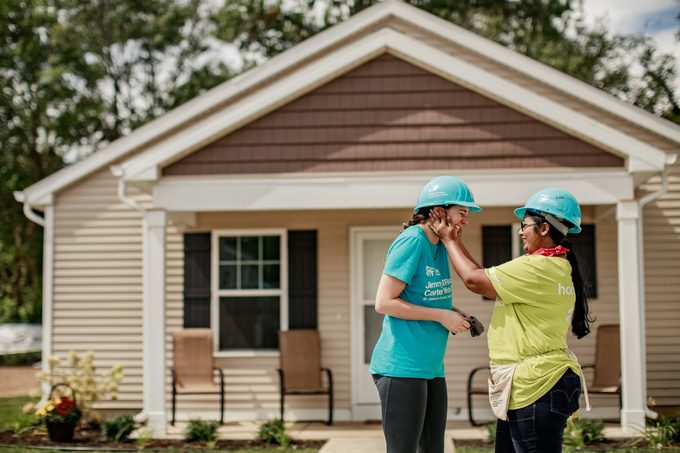
Prior to 2018, Nusrat Zahan and her son lived in a small apartment where, she says, her son was getting older but had nowhere to grow. As a homeowner who participated in the St. Joseph’s County build, she appreciates the way a single act of kindness can inspire the masses.
In building these homes with Habitat for Humanity, Carter was the spark that lit a fiery passion for the work in others.
“People, for nothing in return, were helping people own a home,” Zahan says, giving much credit to the volunteers, many of whom return year after year for this working vacation. “What a humble and selfless act of kindness! And this is all because of the president’s inspiration.”
Jim Williams, CEO of Habitat for Humanity of St. Joseph’s County, says the workers themselves are an inspiration—and a sight to behold. “There’s nothing like 1,000 Habitat volunteers on the job site at the same time,” he says. “The sounds of hundreds of hammers pounding nails at the same time. … What a wonderful sound that is when you know what it represents.”
He also credits much of the project’s success to those after whom it was named. “We smile when we hear people talk about President Carter,” he says. “He leveraged his time in the White House to do something even more significant after his presidency. People know him as a former president, of course, but even more so through his work with Habitat.”
The weight of the Carters’ influence on the build crystallized for Pruitt as the project came to a close. Her final task was to put the address plate on her house. She’d worked all week long, on her home and on her neighbors’, assisting with siding, cabinets, floors and roofs, but by the time she held that drill in her hands for the final task, she was in tears. “There are doors and windows and rooms,” she says. “This is my home. You feel all the emotions, but the strongest one is love.”
Working together
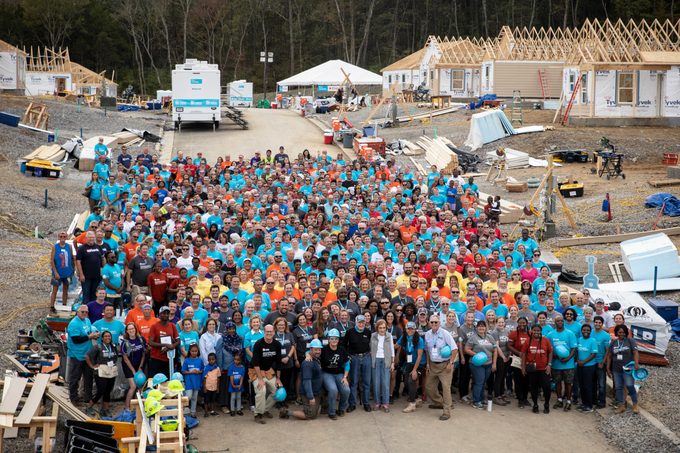
When a friend encouraged Erica Roman Rittle to apply to Habitat in Greater Nashville, her husband was initially hesitant. But after learning that he and his wife would spend 280 hours helping build their own home (along with neighbors’ homes), volunteering at the Habitat for Humanity ReStore and attending classes on subjects such as financial literacy, home maintenance and emergency preparedness, his opinion changed. “We knew we were going to work hard for it and pay for the home we have,” says Neil Rittle.
Pruitt, too, valued the ability to contribute to the building process. “Anything worth having is worth working for,” she says. “The only thing better than free is what I have. My sweat and tears go into this … and you treat it differently when you have to work for it, when it’s not handed to you.”
It’s no surprise, then, that the former president shared their view. After all, he didn’t simply raise money to buy the houses, gifting them to those in need like a hands-off benefactor. He clipped on his tool belt and got to work.
One of Carter’s quotes about his work with Habitat for Humanity emphasizes this collaboration. “That’s one of the things Habitat has given to us: an ability to share, side by side, building a home with families that have never had a decent place to live,” he said.
The former president once said that one of life’s difficulties is bridging the gap between those who are well off and those who lack basic necessities, including a home. And then he did something about it.
The house that Jimmy built
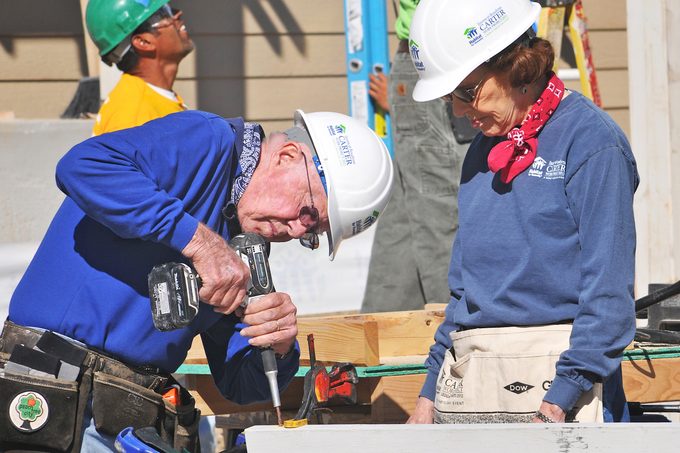
Carter wasn’t the only president to launch a new career after leaving the White House, but his desire to support the quest for affordable housing has unquestionably helped the more than 4,300 families who have been the direct recipients of a Carter Work Project build, both in the United States and in countries as diverse as Mexico, Canada, Hungary, the Philippines, South Korea, India and South Africa. Both he and Rosalynn have been instrumental in amplifying the organization’s impact locally and globally.
It’s hard to imagine what Habitat for Humanity would be without the Carters’ involvement.
The former president has an “incredible capacity to understand big issues and the audacious goals we need as a community and as the world to solve them,” says Habitat for Humanity of Metro Denver’s Lafferty.
In her area, the 2013 Globeville Carter Work Project was a turning point for the community. What were once strong but limited efforts turned into partnerships that have quadrupled the number of households served annually. And the project has grown the awareness of Habitat’s work immeasurably.
What’s more, she says, Carter’s work with Habitat is a point of commonality in a polarized world. “Everyone can agree that having a good home, a healthy home, is the foundation from which everything else is possible,” Lafferty says. “President Carter’s leadership on the Habitat construction sites demonstrates that everyone has something to give. Those with and without skills can work side by side and have a lasting, lifelong impact.”
Paying it forward
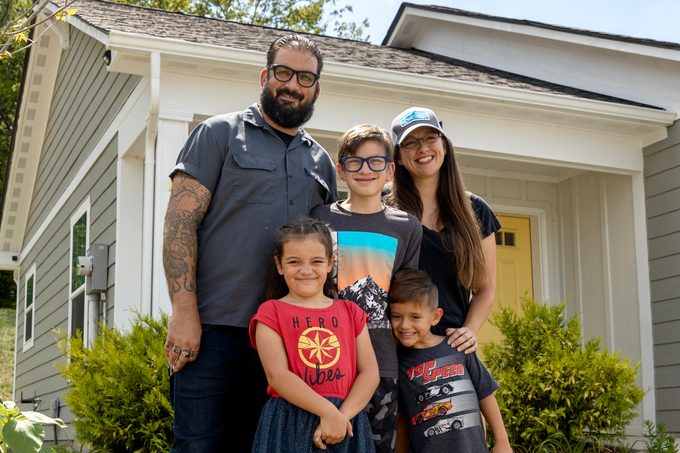
For the Roman Rittle family, the Carters’ generosity in leading by example has changed their lives in unimaginable ways. They moved into their home in February 2020, just weeks before the stay-at-home orders. During the anxious weeks and months that followed, Neil and Erica were grateful their children had a yard to play in and an outdoor place for activities.
At their ribbon-cutting ceremony, Rosalynn gifted them a garden basket complete with gardening tools, a terra cotta pot and vegetable and wildflower seeds, including nasturtiums, reportedly the former first lady’s favorite. Erica made use of those seeds during the early days of the pandemic and continues to cultivate vegetable and flower gardens while learning about native plants and pollinators. Her goal is to have a certified native habitat of wildflowers in her backyard, her own way of “tithing back to nature.”
She pays forward Rosalynn’s thoughtful gift by giving neighbors and the local Habitat for Humanity office fruit from the accidental pumpkin crop she grew one year and by planting blueberry bushes, fruit trees and a strawberry patch.
“We wouldn’t have survived without the generosity of people in our lives,” says Neil. Now, the stability of a predictable and affordable mortgage and the ability to budget has allowed him and Erica to share that generosity with others. They take single-mother friends out to eat, help them purchase Christmas presents for their children and pitch in with diaper deliveries for new moms.
“To have the peace to be able to budget from now until forever gives us the space to help others,” adds Erica. She is currently enrolled in a program to become a school social worker. She cites Habitat as a “huge stepping stone to help[ing] other people” and appreciates that she’s now in a position where she can equip herself with the skills needed to help others.
The Roman Rittles aren’t the only ones paying it forward. Zahan continues to volunteer for Habitat when her schedule allows, and she hopes to be able to do so more in the future. The Jimmy Carter housing initiative gave her and her son an opportunity for stability and peace, and they’re proud to be “part of a community that was built with great love.”
Passing the torch
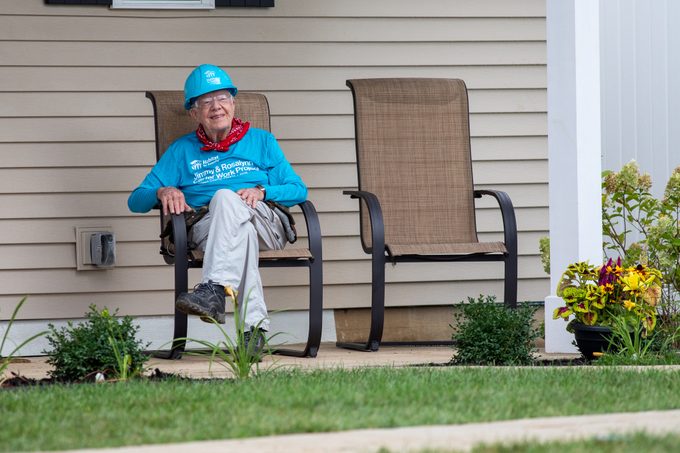
The Carters’ nearly four decades of Habitat volunteerism are coming to a close: The former president is currently in hospice, so the couple won’t participate in the upcoming October 2023 build in Charlotte, North Carolina. And they have officially passed the hammer to longtime Habitat advocates Yearwood and Brooks.
But America will be feeling the impact of their work for years to come. As Williams says, the former president was a man who put his faith into action through his dedication to justice, public service, peace and the care of the most vulnerable. That’s hard to forget.
To Sherry Stinson, senior vice president of brand engagement, marketing and public relations for Habitat for Humanity of Greater Nashville, he is a man who “picked up a hammer and changed the world … a servant leader, which is all too rare these days.”
A civil servant, a former United States president and a humanitarian, Carter has, for more than 35 years, led by example. With Rosalynn at his side, he’s built homes that have afforded peace, security and unprecedented opportunity to the Roman Rittle, Pruitt, Mora and Zahan families—and thousands more like them in communities around the world.
Because of Carter, Zahan says, “I have somewhere to call my own.”
Sources:
- Habitat for Humanity: “Carter Work Projects through the years”
- Habitat for Humanity: “Habitat Humanitarians: The Carters”
- Library of Congress: “Jimmy Carter House”





















